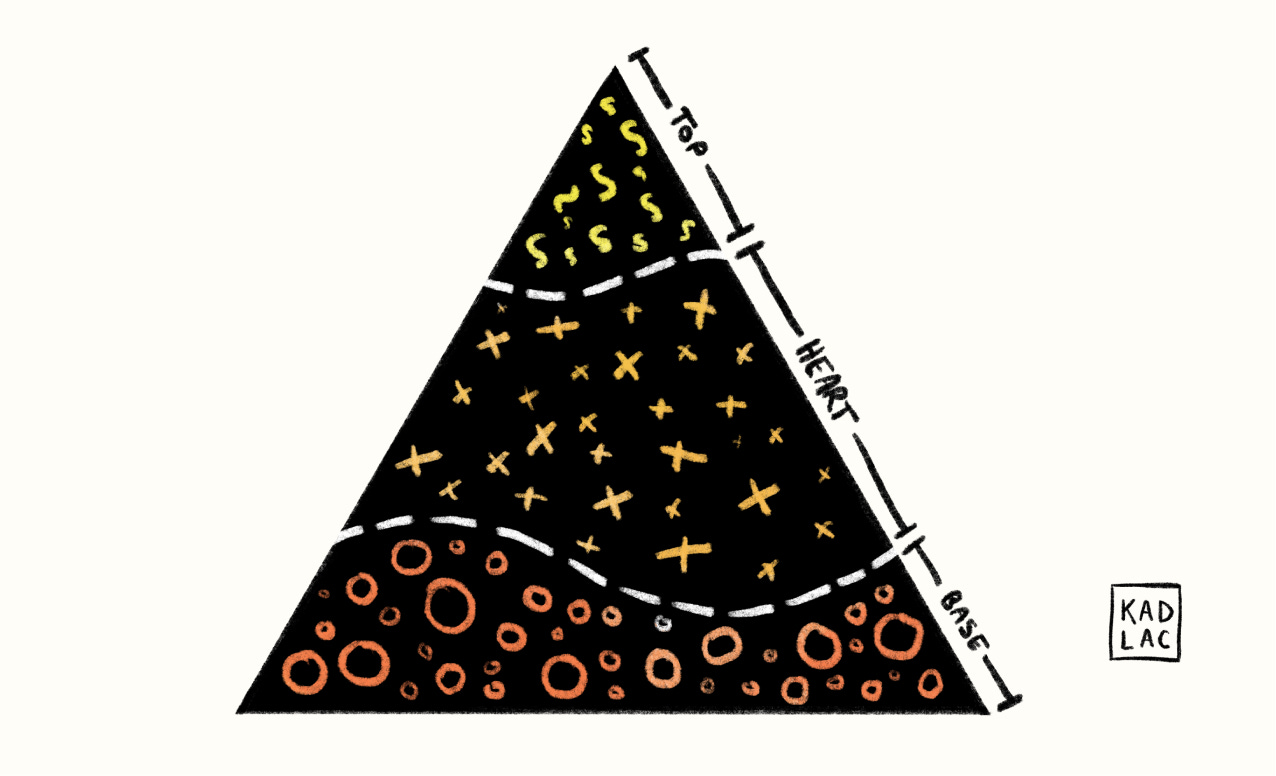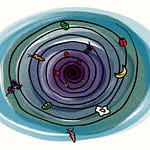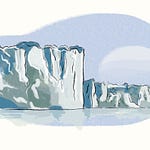👋 Hello! I'm Nate Kadlac, and this is #62 of Plan Your Next. It’s a newsletter that connects design, creativity, and how you prepare for your next thing. If you’re one of the eight new subscribers, welcome!
Good morning from Los Angeles!
Last week, I caught myself in the middle of the Netflix series, Halston. It’s based on the life of Roy Halston, the American designer who rose to international fame in the ‘70s.
The incredible thing about Halston is his constant evolution and curiosity to use different fabrics and materials across the span of his career. During the mid 70’s, he worked on his first perfume, and the process reminded me of how I teach design from the inside out.
All fragrances consist of three notes: The base note, the heart note, and the top note.
Base note
The base note is the most important note. It’s about your past. The smells, feelings, and memories are all the artifacts that define who you are. Base notes bring depth and solidity to a perfume. Without the base, you have no fixatives to strengthen the heart and top notes that sit above. These are fundamental truths, in your life and the base of the fragrance.
These notes aren’t recognized immediately, but the heaviness of the molecules allows them to be revealed after the dissipation of the top two layers.
In design, this is what I refer to as the inside portion of inside-out design. Like the base note of a perfume, it refers to your foundational layer. Your core values, your inspirations, where you grew up, and everything that makes you, unique.
This is where we start in building our new design decisions. It’s a unique combination of traits that can’t be found anywhere else.
Heart note
The note sits in the middle and can be thought of as your soul. It holds all of these base note truths together. The body of the heart note uses more oil, and acts as a buffer between the top and base note. It reveals itself just before the top note disappears, and helps to soften the immediate blow as the base note appears.
The heart note is like a visual mood board, a glue that builds a visual aesthetic from our base layer. It’s the in-between layer communicating our uniqueness to the world. It describes who you are not with words, but with imagery. The visual aesthetic of a heart note combines color, light, textures, and shapes.
Top Note
Also known as the head note, top notes consist of small and light molecules. They command immediate attention but evaporate quickly. The top note must be aggressively sharp and distinct, with the ability to stand out within just a few seconds. If you happen to try a perfume sample at a store, take a whiff of a glass of wine, or choose which deodorant to use quickly, this is the note you’re basing your decision on.
Top notes are like our website home pages, product landing pages, newsletters, email drip campaigns, pitch decks, and Twitter profiles. They must be distinct enough to capture the attention of someone within just a few seconds. We only pray they stick around long enough to smell the other notes, but we’re not always lucky.
All notes work together, but if one’s missing, the entire pyramid crumbles.
People judge books by their cover, so make sure to pay attention to every single note.
⚡️ Inspiration for next week
Your senses, on drugs
Combining ASMR with macro videos is unlike anything I’ve seen. Make sure you have your sound on when watching these beautiful clips of the tiniest of actions.
Your next template shouldn’t be a template
It’s not like I need another reason not to use generic templates, but I can’t help myself. Andrew is spot-on. Relying too heavily on templates shows a lack of thoughtfulness that would otherwise set you apart from other founders, writers, designers, marketers, and on and on. Do the hard work.
Your next great piece of art, explained
I’ve always enjoyed walking around museums casually looking at art. But, there are two different modes when viewing beautiful art.
The first is by being a casual observer. There’s nothing complicated other than observing how a particular piece makes you feel. It’s a valid way to look at art, and this might consist of slowly walking, or speeding through a gallery as if checking off a box. Take it in, and move on to the next.
The second—if you have the time—is to understand the context and history of the piece. This takes much more time, and you won’t see as many pieces. As much as I hate to admit it, having a personal guide is one of the best ways to take advantage of this mode.
When in Paris, we hired a guide for the Louvre and Musée d'Orsay museums, and it was easily one of the highlights of the trip.
This YouTube channel is like having a personal guide hand hold you through the history of great pieces of art.
This particular video walks you through a piece of art you might find in your popular Notion template or set as your background screen saver. The Great Wave by Hokusai.
In 1639 Japan closed its borders and cut itself off from the outside world. Foreigners were expelled, Western culture was forbidden, and Entering or leaving Japan was punishable by Death. It would remain that way for over 200 years.
It was under these circumstances that a quintessentially Japanese art developed. Art for the people that was consumed on an unprecedented scale.
👋 See you next Sunday
If you’ve forgotten who I am, here’s a little bit about me. As always, my calendar is open to chat about your crazy ideas or if you’re creatively stuck.
Have a great week,
Twitter: @kadlac
Web: kadlac.com
Workshop: approachabledesign.co
















